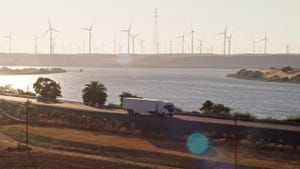FINANCE: Cash Is King
November 1, 2001
Lynn Merrill
Purchasing and financing equipment does not have to be as unpleasant as telling employees they won't receive raises for a year. Companies just have to remember one simple rule: Finance now and save cash for later.
The lifeblood of a business, cash can be used to buy equipment. But if equipment could be financed instead, a company could maintain immediate funds for when they're needed most.
Obviously in the refuse business, collection trucks, containers and other equipment don't come cheap. A single roll-off truck and enough containers to service customers can cost a business $200,000. Operating expenses further add to the tally, which means a new company might not have enough cash to get started. In these cases, financing can make the difference.
“The cost of using cash is substantially larger than the cost of financing when you take into account the time-value of money; the value of cash to your business; and what you would use that cash for if you hadn't [invested it in] something else,” says Corey Bell, vice president of Independent Leasing Associates, Atlanta. “The general rule of thumb is if it's an appreciating asset, you want to buy it. If it's a depreciating asset, then you want to finance it.”
Financing is available either for capital equipment, operating expenses or both. Financing operating expenses can entail 60- to 90-day short-term working loans, depending on an operation's needs and a financing institution's practices. Because it takes time before a company receives revenues, working loans can be based on personal assets or a percentage of accounts receivable. Also, such loans help bridge the gap between the time a company buys fuel and pays the driver, and when it receives payment from customers.
With financing options, there are several differences between a purchase and a lease arrangement, especially when it comes to how much cash will be used in the transaction, the tax advantages and ownership.
A purchase loan may require an equipment buyer to pay a percentage of the purchase price as a down payment. For example, a $200,000 roll-off truck would require a $20,000 down payment. The balance would be financed over a fixed term where a principal and interest payment would be made. Although the payment's principal amount is not tax-deductible, the business now has a depreciable asset.
Check with a tax advisor regarding interest payment deductions.
Additionally, financing institutions may require a company to maintain a minimum account balance to offset interest rates while it pays off a loan. This ties up additional capital.
A purchase rate of 8 percent may sound good, but companies should be aware that the numbers aren't as rosy when combined with compensating balances of 20 percent and money's future value. This would equal paying 24 percent in interest.
Equipment, on the other hand, can be leased with little or no down payment. For example, leasing a $200,000 roll-off truck “saves” $20,000 for daily cash management. Plus, this allows a company to retain other account balances. Lease payments can be tax deductible and depending on a lease's structure, a business can purchase the asset for a residual value at the end of the lease term. There also is an additional tax deduction each year for the purchase of tangible equipment.
“I believe [the tax deduction] is up to $24,000 now,” Bell says. “If a company buys new tangible equipment under [a] conditional sales agreement where the customer owns it, the government allows [businesses] to take $24,000 out of their taxable income [in the year the asset is acquired].”
But Bell warns that a company looking for financing should avoid the temptation to shop rates. This is because each time a business fills out a credit application, it will show up on the company's credit rating and make it appear as if the company has financed additional equipment.
“[Financing institutions] have to assume you were declined or they gave you a deal you didn't like,” Bell explains. “We'll assume you were declined because we have no way of knowing, and then we'll require letters … from you. It's a nightmare.”
As an alternative, Bell suggests a company obtain a quote from a leasing company without filling out the credit applications.
Nevertheless, leasing can be advantageous. Freeman's Garbage Removal Inc., Cleveland, Ga., leased equipment to help grow its business.
“We were in business for a few years, and our routes were so large,” says Elisa Freeman, Freeman's CFO. “We had trouble getting our first lease because companies were hesitant, and we had never been in any kind of a lease or agreement. They wanted [us] to be in business for so many years, and to have credit references. We really didn't have that when we first started.”
The company Freeman was trying to purchase carts from suggested leasing as a way to keep money available for other purposes.
“Other lending institutions wanted 10 percent down, and it [would have taken] a bigger chunk out of our savings,” Freeman says. “We need that for daily operations, so [leasing] helped [us] to keep that money and still get the equipment … and not have to wait.”
You May Also Like


